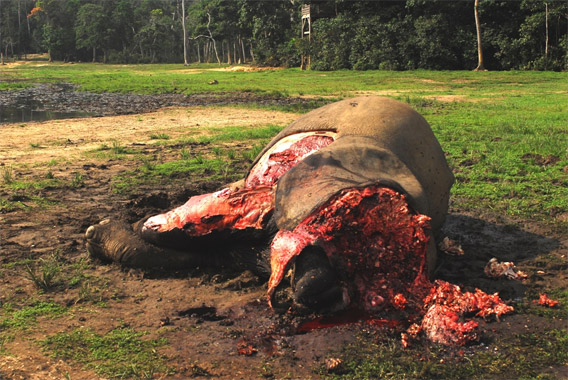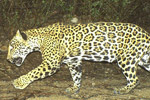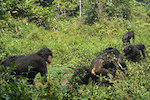WARNING: Graphic photos below.
35,000 elephants killed in Africa in 2012 for black market ivory trade
A joint force of the Wildlife Conservation Society (WCS) and government authorities are in the midst of carrying out a series of raids against poachers in Mozambique aimed at halting the illegal killing of elephants in Niassa National Reserve, the country’s largest protected area. Six men, thought to be responsible for killing 39 elephants in 2014, were arrested in an early morning bust in the town of Marrupa, just south of the park.
“This is a big problem that has spread throughout Africa,” said Cristián Samper, president and CEO of WCS, who is currently in Mozambique. Recent studies found that around 35,000 elephants were killed on the continent in 2012, about four every hour, to satiate the illicit-but-profitable global ivory trade. The forest species (Loxodonta cyclotis) that inhabits the rainforests of the Congo Basin has been particularly hard hit – its numbers have declined by 72 percent in the last decade.

Lesser-known than their savannah cousins, a genetics study in 2010 found that forest elephants (Loxodonta cyclotis) are a distinct species, as far removed from savannah elephants as Asian elephants are from mammoths. Photo by Rhett A. Butler.
To bring the continent-wide poaching problem under control, WCS is part of a team of 17 conservation groups working in concert to fight poaching on multiple fronts. “Our approach to the broader issue is a three-prong strategy,” Samper said. “Stop the killing, stop the trafficking, stop the demand.”
The current series of raids is focused on the first aspect of that strategy – to end the immediate deaths of so many elephants. This week’s success is possible thanks to a “hugely significant change in the government’s commitment” to end poaching, said Alastair Nelson, country director for WCS in Mozambique.
A law passed in June of this year aims to protect not just elephants but all of Mozambique’s biodiversity. The new regulations are a response to protect wildlife as a resource that helps contribute to the quarter of a billion U.S. dollars brought in annually by the Mozambican tourism industry. Mozambique’s leaders have also been pressured by their neighbors, South Africa and Tanzania, as well as the World Bank, the U.S., and France, to rein in the country’s poaching problems, Nelson said.
But he was quick to add that there is also a resolve at the highest levels of government to see the law succeed. After Sunday’s raid, “A government minister called the park warden and said, ‘You must use this law to prosecute these guys,’” Nelson said. It makes poaching a punishable crime, he added, meaning that the men captured in the raid could go to prison for eight to twelve years. The government also sent 12 newly trained environmental police to Niassa, which is larger than Switzerland at 42,000 square kilometers.
In addition to the arrests on Sunday, authorities also confiscated two hunting rifles, 60 rounds of ammunition, and 12 tusks, worth more than $150,000.

A dead forest elephant with its tusks removed by ivory poachers. Photo by: Andrea Turkalo/WCS.
In the past few years, WCS staff, who run the park jointly with the Mozambican government, say they have noticed a shift in the tactics of poachers.
“This is not just a marginal issue in one place with local communities trying to make a living,” Samper told mongabay.com. “This is very clearly an issue that’s being driven by organized crime and fueled by the demand for ivory” in Asia and the United States, he said.
That worldwide demand has made the ivory trade very lucrative, and criminals have developed highly structured networks that cross international borders. Indeed, four of the six men arrested in the Marrupa raid were citizens of Tanzania, into which Nelson and his colleagues believe the trafficking network extends to move the ivory up to the Kenyan port of Mombasa. Then, it’s smuggled to black markets around the globe.
To combat the killing of elephants for their ivory, the authorities have begun gathering intelligence to track down and ultimately prosecute poachers. A year of detective work allowed the arrest of the men in Marrupa.
“They are a professional poaching gang who are very good at their job,” Nelson explained. “Meeting them in the field, typically when they are armed with these two hunting rifles and an AK[-47] or two, it’s far harder to apprehend them than in an intelligence-led raid like this.” He said it’s important for authorities to evolve as poaching strategies change.

Niassa National Reserve in northern Mozambique, along the border with Tanzania. The reserve covers 42,000 square kilometers, larger than the Netherlands. Map courtesy of Global Forest Watch. Click to enlarge.
Samper said he’s been struck by conflicting emotions on his visit to Niassa. On the one hand, he expresses his sadness at seeing elephant “carcass after carcass” during helicopter surveys of the reserve. Poachers pick off one to two elephants every day in the park, WCS believes.
But he’s also heartened by the success of the raids, as well as the lessons from history about the resiliency of these animals. “We’ve been here before,” Samper said. Elephant populations plummeted in the 1980s, before international regulations stymied the international ivory trade.
Once those laws were enforced, “The populations of elephants recovered,” he said. “We know that this can be done in the places where we have resources and people. We know that the elephant populations can recover relatively quickly, and that’s what will happen if we all really focus on doing this and the kind of work we’re doing in Niassa.”
Citations:
- UNEP-WCMC, UNEP, and IUCN. “World Database on Protected Areas.” Accessed on 11 September 2014. www.protectedplanet.net. 288-307.
Related articles
‘A global tragedy’ in the making? Thailand plans highway expansion through World Heritage Site
(08/29/2014) Dong Phayayen Khao Yai Forest Complex (DPKY-FC) is the largest tract of surviving forest in central Thailand, renowned for its biodiversity. Now, the Thai government is planning major expansions to a road that bisects the complex – which scientists say will bar animal movement throughout their natural ranges, result in higher rates of road kill, and give hunters and loggers increased access to the forest.

(08/22/2014) Every year, between 20 and 30 tigers are poached. Illegal logging is reducing the tigers’ habitat, and illegal hunting is reducing its food supply. However, these are not the only threats to wild tiger survival — other problems are cropping up and taking a toll on the iconic big cat.
Logging of Russian Far East damaging tiger habitat, few intact forests protected (Part I)

(08/19/2014) The destruction of Russian forests to supply timber to international markets is becoming one of the biggest threats to the world’s largest cat, the Siberian tiger. Russia has more forests than any other country, with more than half of the world’s coniferous forests. However, worldwide demand for high quality timber, along with weak regulations, has led to widespread logging of Russia’s trees.
20 percent of Africa’s elephants killed in three years

(08/19/2014) Around 100,000 elephants were killed by poachers for their ivory on the African continent in just three years, according to a new paper in the Proceedings of the National Academy of Sciences. Between 2010 and 2012 an average of 6.8 percent of the elephant population was killed annually, equaling just over 20 percent of the continent’s population in that time.
Elephant poaching soars as Sumatran forests turn into plantations

(08/14/2014) There has been a spike in elephant deaths in Sumatra this year, and conversion of rainforest to plantations is one of the main causes. The number of Sumatran elephants poached in the province of Riau so far this year is staggering, with 22 reported kills in the first six months of 2014 compared to 14 for the entirety of 2013.
Jane Goodall: how many elephants will be killed on World Elephant Day?
(08/12/2014) Marking World Elephant Day, a designation intended to raise awareness about the plight of elephants that are being widely poached for the ivory trade, primatologist Jane Goodall urged people to have greater compassion for Earth’s largest land animals.
Want to save Africa’s elephants? Close all ivory markets

(08/07/2014) The only way to save the long-suffering elephants of Africa is to close every ivory market on the planet and destroy all ivory stockpiles, according to a bold new essay in Conservation Biology. Written by Elizabeth Bennett, the Vice President for Species Conservation at the Wildlife Conservation Society, the paper is likely to prove controversial.
World Ranger Day: honoring our wildlife protectors
(07/31/2014) Like Memorial Day, when we honor our nation’s military veterans, World Ranger Day is a day to recognize and celebrate the thousands of rangers who put their lives on the line as they protect wildlife and natural resources around the world.
Seeking justice for Corazón: jaguar killings test the conservation movement in Mexico

(07/31/2014) Eight years ago, a female jaguar cub was caught on film by a motion-triggered camera trap set in the foothills of canyons, oak forest, and scrubland that make-up the Northern Jaguar Reserve, just 125 miles south of the U.S.-Mexico border. Three years later, in 2009, the jaguar reappeared on film as an adult. They called her ‘Corazón’ for the distinctive heart-shaped spot on her left shoulder.
Poachers target elephants, tigers in Sumatran park
(07/31/2014) The Leuser Ecosystem in Aceh, Indonesia is gaining the attention of international animal traffickers, according to the Leuser Conservation Forum (FKL). From the beginning of 2013, FKL patrols have dismantled 282 makeshift traps targeting high value threatened species, and the situation is getting worse.
Conservation controversy: are bonobos protected in the right ways and in the right places?

(07/30/2014) Bonobos, endangered great apes, continue to survive in forests south of the Congo River in the DRC, albeit under constant threat of hunting, loss of habitat and the growing demands of an increasing human population. Conservationists have, over the years, tried and tested different conservation strategies to protect the last of the bonobos. And some of these strategies have invited considerable debate.